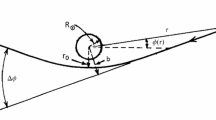Abstract
It is shown here that Newton’s gravity law can be derived from the uncertainty principle. The idea is that as the distance between two bodies in mutual orbit decreases, their uncertainty of position decreases, so their momentum and hence the force on them must increase to satisfy the uncertainty principle. When this result is summed over all the possible interactions between the Planck masses in the two bodies, Newton’s gravity law is obtained. This model predicts that masses less than the Planck mass will be unaffected by gravity and so it may be tested by looking for an abrupt decrease in the density of space dust, for masses above the Planck mass.
Similar content being viewed by others
References
Adelberger, E.G., Heckel, B.R., Nelson, A.E.: Tests of the gravitational inverse-square law (2003). arXiv:hep-ph/0307284
Ashby, N.: Relativity in the global positioning system. Living Rev. Relativ. 6, 1 (2003)
Ashtekar, A.: New variables for classical and quantum gravity. Phys. Rev. Lett. 57(18), 2244–2247 (1986)
McCulloch, M.E.: Modelling the Pioneer anomaly as modified inertia. Mon. Not. R. Astron. Soc. 376, 338–342 (2007)
McCulloch, M.E.: Minimum accelerations from quantised inertia. Europhys. Lett. 90, 29001 (2010)
McCulloch, M.E.: Testing quantised inertia on galactic scales. Astrophys. Space Sci. 342(2), 575–578 (2012)
Nesvizhevsky, V.V., et al.: Quantum states of neutrons in the Earth’s graviational field. Nature 415, 297–299 (2002)
Rovelli, C.: A dialog on quantum gravity. Int. J. Mod. Phys. D 12, 1509–1528 (2003). http://arxiv.org/abs/hep-th/0310077
Acknowledgements
Thanks to B. Kim for encouragement.
Author information
Authors and Affiliations
Corresponding author
Rights and permissions
About this article
Cite this article
McCulloch, M.E. Gravity from the uncertainty principle. Astrophys Space Sci 349, 957–959 (2014). https://doi.org/10.1007/s10509-013-1686-9
Received:
Accepted:
Published:
Issue Date:
DOI: https://doi.org/10.1007/s10509-013-1686-9




